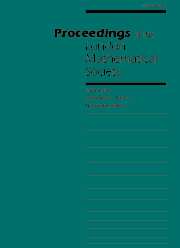No CrossRef data available.
Article contents
PROBABILISTIC STUDY OF A DYNAMICAL SYSTEM
Published online by Cambridge University Press: 03 November 2000
Abstract
This paper investigates the relation between a branchingprocess and a non-linear dynamical system in $\mathbb{C}^2$.This idea has previously been fruitful in many investigations, including that of the FKPP equation by McKean, Neveu, Bramson, and others.Our concerns here are somewhat different fromthose in other work: wewish to elucidate those features of thedynamical system which correspond to the long-term behaviour of therandom process. In particular, we are interested in how the dimensionof the global attractor corresponds to that of the tail $\sigma$-algebra of the process.The Poincar\'e--Dulac operator which (locally) intertwinesthe non-linear system with its linearization may sometimes be exhibited as aFourier--Laplace transform of tail-measurable random variables; but things change markedly when parameters cross values giving the `primary resonance' in the Poincar\'e--Dulac sense.Probability proves effective in establishing {\it global} properties amongst which is a clear description of the global convergence to the attractor.Several ofour probabilistic results are analogues of ones obtained by Kesten andStigum, and by Athreya and Ney, fordiscrete branching processes. Our simpler context allows the use of It\^o calculus. Because the paper bridges two subjects, dynamical-system theory and probability theory, we take considerable care with the exposition of both aspects.For probabilist readers, we provide a brief guide to Poincar\'e--Dulac theory; and we take the view that in a paper which we hope will be read by analysts, it would be wrong to fudge any details of rigour in our probabilistic arguments. 1991 Mathematics Subject Classification: 60H30, 60J85, 34A20.
Information
- Type
- Research Article
- Information
- Proceedings of the London Mathematical Society , Volume 81 , Issue 3 , November 2000 , pp. 618 - 650
- Copyright
- 2000 London Mathematical Society

